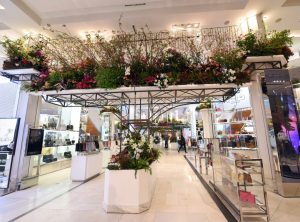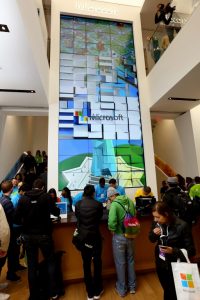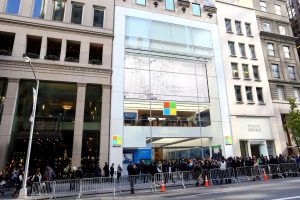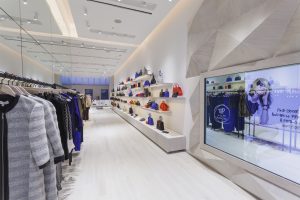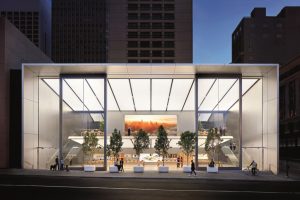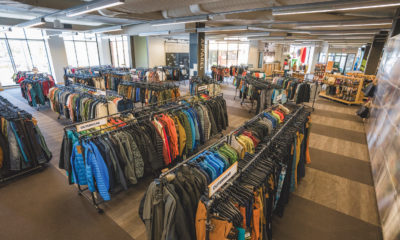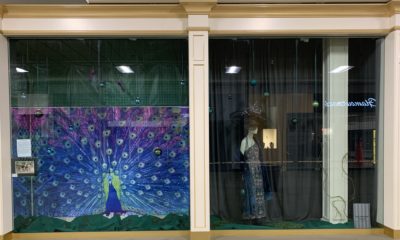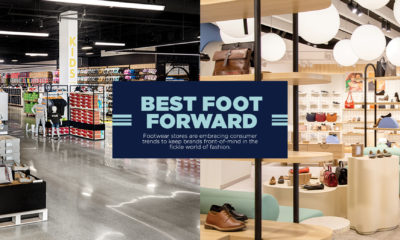Do you remember the first time you went to Times Square or saw a Barneys Christmas window? Think about the annual spring Macy's Flower Show or the local Whole Foods produce department. Do you remember the first time you stopped and drank it all in?
The magic of visual merchandising makes you pause and take notice.
As I consider what works and what doesn’t when retailers and brands blend emerging technology with traditional visual merchandising – aka dynamic VM – I think it’s important to shine a spotlight on the good stuff. There are and have been a wide variety of experiments and attempts to use screens, beacons, sensors and the like to improve sales. There are many, many examples of bad executions resulting in stale content on the screen, dead screens or product configurators no one wants to use. Many get installed only to be pulled out a few fiscal years later and labeled failures.
I have plenty of pictures and videos of failures, but I won’t bore you with those. Instead, I want to share some examples of dynamic VM installations that inspire me.
American Eagle Outfitters, Times Square, New York

American Eagle Outfitters digital billboard, Times Square, New York
Courtesy of Chuck Palmer, Columbus, Ohio
What Works: Form, presence, motion. In a sea of bright lights, the sculptural form of this digital “billboard” stands out. The content is tailored to cascade down from the smaller screens to the larger screen closest to the street. Its user-generated content is an excellent way to bring customers into the fold, from wherever they connect with the brand, and elicits a sense of community.
Advertisement
What Doesn’t: The lack of immediacy. In any user-generated campaign, the content must be supervised and filtered. In this case, an AEO customer standing in Times Square can’t immediately interact with the sign. Ideally, when a grand gesture like this is made, it resonates beyond the execution. For example, the Forever 21 interactive billboard shows a model looking out over Time Square and plucks pedestrians out and puts them in her shopping bag, among other things.
Why: This works because it is concept-driven, not technology-driven. While that tower might not be the ideal form, it is a beacon and naturally draws the eye. The corner allows all sorts of interesting applications, as well as the possibility of interactive engagement.
Converse Lovejoy Wharf, Boston

Converse Lovejoy Wharf, Boston / Couresy of Chuck Palmer, Columbus, Ohio
What Works: Almost everything. This is one of the best examples of dynamic VM I’ve found. Eighteen squares – 15 static and three in motion; a perfect blend of traditional and digital. I love how the video clips evoke the tone and attitude of Converse’s All Star and Chuck Taylor brands and the static squares put the T-shirts available below on display.
What Doesn’t: There’s no real visual hierarchy; it’s easy to focus on the video and not the T-shirts. However, the point of this entire store is to tell the Chuck Taylor and All Star stories, so this flaw is very forgivable.
Why: The blend of analog and digital. The screens are the same size as the T-shirt frames and add just enough animation to draw the eye from anywhere in the store.
Advertisement
Connect @ Macy’s, Columbus, Ohio

Macy's click and collect, Easton Town Center, Columbus, Ohio / Courtesy of Chuck Palmer, Columbus, Ohio
What Works: Screens doing what they do best: capturing the attention of customers and facilitating sales. Macy’s created this digital beacon for their new click and collect (C&C) service.
What Doesn’t: The video loop on the messaging screen is repetitive. If a customer has to wait for an associate to retrieve a purchase or gather more information, the screen can soon become boring. I observed customers quickly returning to their smartphones. Instead, this could sense products being picked up and present relevant messages (without disclosing the customers’ purchases or preferences).
Why: Behaviorally, C&C is still new and many customers are trying it out for the first time. This display uses a nice combination of techniques to deliver a clear sense of where to go to collect their purchases.
Microsoft Flagship Store, Fifth Avenue, New York

Microsoft Fifth Avenue Flagship, New York / Courtesy of Chuck Palmer, Columbus, Ohio
What Works: Volume, volume, volume! As the primary visual merchandising tool, the large arrays draw people in and effectively change the environment from moment to moment.
Advertisement
What Doesn’t: There is little to no blending or dialog between the one-way, advertising-level messaging on the screens and the products for sale. For example, the Surface products are featured on the screens, but they are not displayed close to the screens. There is little to no interactivity, and while this happens with the products and the staff, the screens could be used to turn tourists into brand adopters. (One exception to the lack of digital interaction, the second floor Minecraft feature anchors the Minecraft department and allows customers to play the game on a larger-than-life 12-screen array.)
Why: Spectacle. The sheer number of screens and the content on them is impressive. They command attention and make customers pause and consider the message, products and brand.
Nordstrom Beauty Concierge, Seattle

Nordstrom interactive concierge / Courtesy of Chuck Palmer, Columbus, Ohio
What Works: An engaging experience in an open-sell environment. While this interactive display is not embedded in a traditional display, it is in dialog with Nordstrom’s open-stock visual merchandising approach.
What Doesn’t: While it is informative and interactive, it is not directly connected to a transaction.
Why: An elegant, web-like experience. The screen acts as a gateway to the cosmetics department and presents a cross-section of products from the various branded counters. The data gathered from the display aids in that store’s inventory management.
Verizon Device Wall, Mall of America, Bloomington, Minn.
Verizon Wireless Destination Store, Mall of America, Bloomington, Minn. / Photography: Brandon L. Jones
What Works: The interactive device wall shows in-stock products. Devices can be compared and contrasted, tested and felt, while features and benefits are brought to life on the large array.
What Doesn’t: Maintenance and content management. The complexity of hardware configuration makes this difficult to maintain. While not easy to deploy across a large scale chain of stores, Verizon has developed innovative ways to install the best parts of this experience.
Why: It’s the best of both worlds: a web-like shopping/comparing experience coupled with nearby sales associates and products to close the sale.
Rebecca Minkoff, SoHo, New York
Rebecca Minkoff Flagship Store, SoHo, New York / Courtesy of Rebecca Minkoff, New York
What Works: Rebecca Minkoff has built her brand squarely with the customer at the center. The store leverages customers’ digital lifestyles to inform a high-touch in-store experience. The mobile app makes it easy to let the store know when you’ll be there and what you’d like to try on. The staff sets up a connected fitting room with your choices.
What Doesn’t: The large mirror in the main showroom can be a bit of distraction from the products on display. It acts like an endless aisle application, which is appropriate since many Rebecca Minkoff customers are happy to receive their purchases at home.
Why: The store is defined as “just another touchpoint,” and the information that comes from the interactive experiences builds more data to use strategically, just as the web and mobile experiences do.
Apple, Union Square, San Francisco
Apple Union Square Flagship, San Francisco / Couresy of Apple, Cupertino, Calif.
What Works: That screen! It acts as a beacon to draw in tourists and locals. It is beautifully designed into this impressive flagship store’s interior, creating major curb appeal through its glass façade.
What Doesn’t: While I’m sure whatever appears on the screen is beautiful … Oh, what am I saying? There’s nothing wrong with this.
Why: It’s hard to argue with the super-high resolution of a massive 6K video wall, but size only matters when the content is just as big. Apple has ambitious plans to use the impressive video wall in the store’s “Forum” space for education, creative and gaming events and movie and music premieres. This goes well beyond moving the merchandise in their hometown flagship store – it’s grand gesturing at its best.
I would love to hear what you think works well out there in the retail landscape. Comment on social media with #DynamicVM, or connect with me @cxChuck.
Chuck Palmer is a retail strategist working at the convergence of consumer behavior, technology and innovation. He works with retailers and brands, agencies and vendors on ideal consumer experiences. He has worked with JPMorgan Chase, Airstream, Macy’s, Crate & Barrel, Nintendo and JohnRyan among others. Chuck is a regular contributor to industry publications and is often called on for expert opinions. Find him on social media @cxchuck and ConsumerXretail.com.
|
|
Be sure to check out Chuck’s International Retail Design Conference (IRDC) session, “Dynamic VM: A Practical Guide to Enhancing Visual Merchandising with Technology,” in the Digital Integration power track, 2 p.m., Thursday, Sept. 15, 2016, in Montreal. For more details about his session and others, visit irdconline.com. |


 Photo Gallery2 days ago
Photo Gallery2 days ago
 Headlines1 week ago
Headlines1 week ago
 Headlines2 weeks ago
Headlines2 weeks ago
 Sector Spotlight2 weeks ago
Sector Spotlight2 weeks ago
 Headlines1 week ago
Headlines1 week ago
 Headlines4 days ago
Headlines4 days ago
 Headlines2 weeks ago
Headlines2 weeks ago
 Designer Dozen1 week ago
Designer Dozen1 week ago






